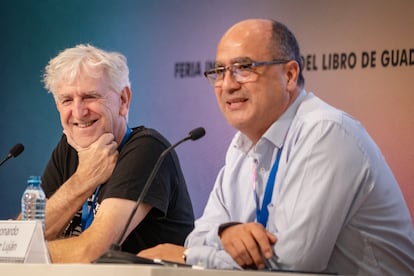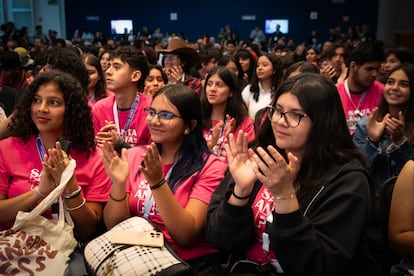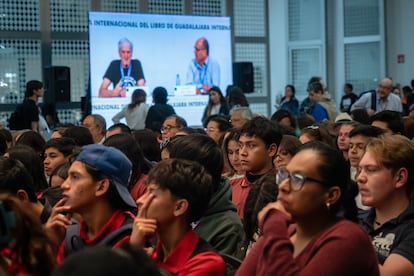At 15 years old, Jaime Pulido is surprised after meeting Juan Luis Arsuaga (Madrid, 70 years old). The dark-skinned boy, tall and thin as an asparagus, emerged smiling on Tuesday from a talk that the Spanish paleoanthropologist gave within the framework of the Guadalajara Book Fair (FIL) to an auditorium packed to the brim with teenagers, young high school students who They arrived forced by their teachers. For Pulido, however, far from being another torture imposed by the tutors, the meeting was “very interesting” because, he says in amazement, “he came to talk to us about our ancestors.”
Arsuaga, famous for his ability as a science communicator, converted the enormous auditorium Juan Rulfo of the fair in a class session to encourage the interest and curiosity of a generation tied to the mobile screen, but who was settling in at that moment listening to the stories of a 300,000-year-old skull, Miguelonor the pelvis Elvisfound in the Sima de los Huesos de Atapuerca, in Spain, one of the oldest sites of remains of human beings in Europe. Arsuaga achieved what he wanted: for young people to be surprised by science, history and nature as he has done since he was a child.
Ricardo Villanueva Lomelí, outgoing rector of the University of Guadalajara, said during the inauguration of the largest fair in Spanish that “FIL is freedom, It is a cathedral of thought” and on Tuesday Arsuaga became its archbishop celebrating mass. It began with a wink to its young audience that minutes before was rummaging through their cell phones, with the very young couples kissing and touching each other, the mothers trying to keep their youngest children calm and the teachers with their eyes fixed so that none of them escaped them. “This is the incubator for new readers,” said the presenter of the event. And Arsuaga took the wink and returned it as a joke to his audience: “I am the old man of the tribe, which is an honor,” said the scientist when he spoke.
This son of a soccer player father and a mother who studied art, began by remembering that distant day when he ran away from school—”don’t do it,” he warned his audience—in the Basque Country, where his family had moved, to visit a excavation with archaeological sites, a seat of Neanderthals. On the way there was an ancient stone bridge where, for him, mythical beings were concentrated and he found this “conversation” between the mythical and scientific evidence wonderful. That is to say: the world that would fascinate him throughout his life opened up for him, that of History, with a capital letter, and that of anthropology that would help him answer the philosophical questions that humans have asked themselves since reason entered us. in the head: who we are, where we come from and where we are going. Although in the talk he made a small change to the Basque: who we are, where we come from and when we have dinner. “It’s the nearest future,” he said smiling about the dinner.
After visiting those caves with excavations, the young Arsuaga imagined that he was an Australian aborigine, the only one of his kind in all of Spain. A book of ethnographic literature showed him tanned faces, red sands, the life of those aborigines, a work of anthropological expedition that still marks him and he dreams of crossing those arid fields to meet people who lead a “Paleolithic life”, a region that “it is the last place on earth where the old spirits have lived.” In that territory forgotten by the modern, Arsuaga assures, there is a wealth of human beings “who have not lost their humanity,” as is the case with those of us who live in cities, always self-absorbed, selfish, isolated in our small worlds. That encouraged him to learn the history of our ancestors and their ways of relating. Throughout her apprenticeship, first in Madrid with a scholarship in 1976 — “take advantage of the scholarships,” she advised her young audience — and then with the study of other disciplines, earth sciences, Arsuaga became one of the most respected voices in the scientific world.
The paleoanthropologist told his young students to be attentive, because we are all “walking on fossils.” The stones that are extracted to make floors, pillars, and walls are full of history, because they contain marine fossils from when these territories were covered by sea, he explained. “Nothing is discovered by chance,” said Arsuaga. “You have to pay attention to the signs, see what others don’t see,” he said. As happened with the famous archaeological site of Atapuerca, which brings together sites with some of the oldest remains of human beings in Europe, at least 800,000 years old. It was found while train tracks were being built during the industrial boom in 19th century Spain.

It is a place that fascinates the scientist. The pelvis was found there Elviswhich together with that of the australopithecus Lucyare among the best preserved. “It’s very light, it doesn’t weigh anything,” Arsuaga said about the pelvis. “People think that the pelvis is something that weighs a lot, but no, because it should make us efficient in movement, it is a spongy bone, with a lot of air, that is little preserved,” he explained. That is why it is rare for experts to find a specimen and the discovery of one so old is a world event. At the time, the expert recalls, the American press called it “Elvis’s most important pelvis,” in reference to the musician. “He who knows the pelvis knows everything, because it has to do with childbirth, movement, it determines the development of the newborn and has a lot to do with sex,” he said to elicit mischievous giggles from the teenagers.
Arsuaga wanted to make it clear in his speech that lasted more than an hour that the important thing is always curiosity. He recalled a trip he made together with other writers and intellectuals on a “cultural train” from Madrid to Zaragoza. When journalists asked several personalities what they did during the trip, Arsuaga heard one explain that he was finishing a novel, another was reading or finishing some pending work. He spent the trip looking out the window. “No one was interested in nature, that place where everything amazes you, where things happen,” he said. “I am still the child who looks out the window on trips,” said the man who has made science his place in the world. For this reason, he recommended to his young audience: “The message for young people is that nothing is achieved by chance. It is important to be attentive to the opportunities that life gives us and we must see them, understand them and hold on to them. “Things don’t happen by locking yourself at home.” It is said by the old man of the tribe, the 70-year-old man who managed to amaze a room full of students, like the 15-year-old boy Jaime Pulido. And he managed for more than an hour to look away from a wise man of the mobile.


